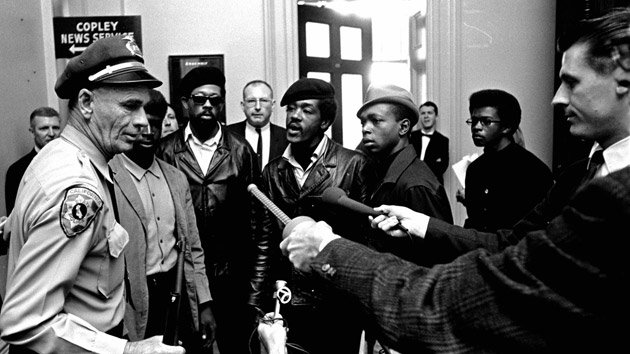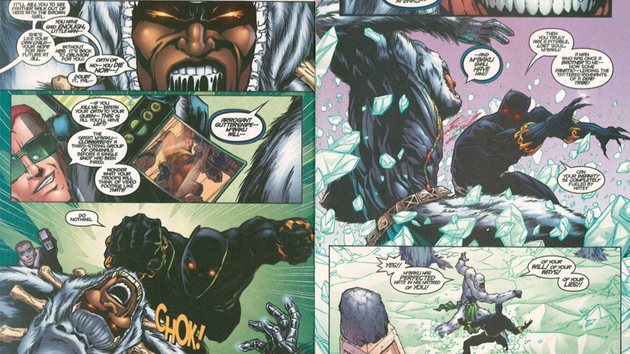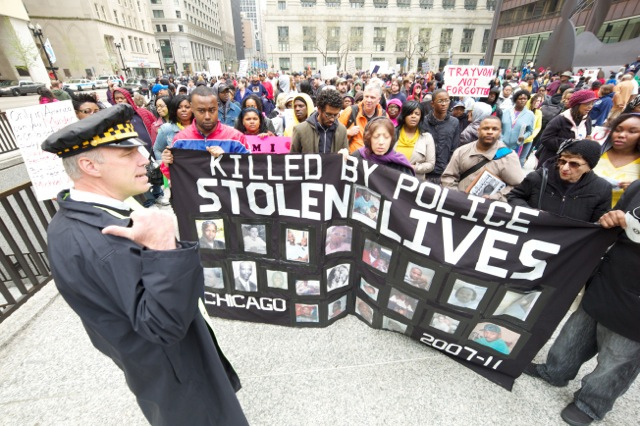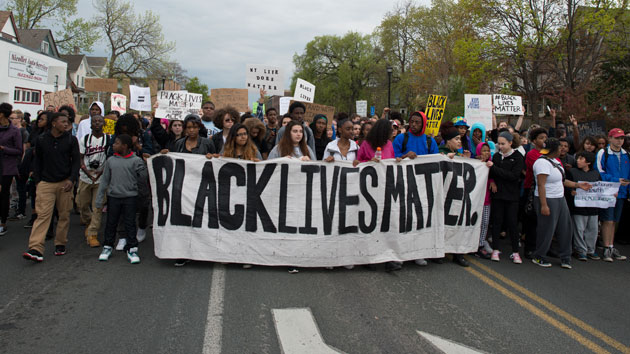
Black Panther leaders argue with a state policeman in Sacramento, California, in 1967. AP
Stanley Nelson had just returned from a screening of his new documentary, “Black Panthers: Vanguard of a Revolution,” at the Apollo Theatre, when he saw her—Beyoncé—backed by dancers adorned in jet black outfits, berets, and blown-out hair, dancing with authority before thousands of raucous fans at the centerpiece of mainstream American culture, the Super Bowl. “I was shocked and amazed by it,” Nelson recalled later. “But also, it was beautiful.”
The award-winning filmmaker had been swept up in a Black Panther moment. And in a way, so is the rest of the country. Much like during the late 1960s, protests over police brutality in the past year have given rise to the Black Lives Matter movement. The film serves as a reminder that the issues the Black Panthers combated—poverty, economic disparity, tensions between law enforcement and the black community—remain relevant today.
The film, told mainly through the voices of the Panthers’ rank and file, captures the group’s rise and long, steady fall as a cultural and political force, from its infamous gun-touting demonstration at the California statehouse to then-FBI director J. Edgar Hoover’s efforts to disrupt and destroy the Panthers’ national influence. Nelson’s documentary also gets at the internal struggles as women rising through the Panther ranks pushed for gender equality.
The film, which premiered at the Sundance Film Festival last year, has largely been praised, although some insiders have taken issue with Nelson’s portrayal. Former Panther leader Elaine Brown dismissed the film as a “two-dimensional palliative for white people and Negroes who are comfortable in America’s oppressive status quo.” Nelson chose not to respond directly, saying simply, “I don’t think there’s anything about the Panthers that anybody can agree on. But I think in some ways, this film comes really close.”
You can decide for yourself, in any case: The film premieres Tuesday, February 16 on PBS. For the occasion, I caught up with Nelson to talk about the Black Panthers’ legacy and public misconceptions, and the resurgence of black activism around policing and criminal justice.
Mother Jones: How would you describe the Panthers’ influence since their heyday?
Stanley Nelson: Besides the few tangible things that they did, like the breakfast with children program, their lasting influence was really cultural. This aggressive stance among African Americans—nobody had ever seen anything like that. It’s hard to understand that if you weren’t around back then. You can’t imagine hip-hop without the Black Panthers. Today, hopefully, the movement can be an inspiration to people. These were people who made mistakes but they were trying to change things.
MJ: Why did you want to tell this history?
SN: I started eight years ago. I thought the Panthers were still very relevant, and I thought it was a story people didn’t know—the people that did know it had a lot of misconceptions, whether you loved the Panthers or hated the Panthers. So many things that they were fighting for are things that we are still struggling to accomplish.
MJ: How did their cultural influence change over time?
SN: One of the fascinating things you see in the film is that the Panthers were supported by a large section of the population. It wasn’t just black folks. You see Eldridge Cleaver speaking to thousands of people who are 90 percent white. You see people carrying signs in Chinese, in Japanese, in Spanish, in support of the Panthers. As time has gone on, they’ve been cast as this militant group that hates white people and they are out there on this island by themselves. That’s not how they were thought of at the time. In the film, you see people having anti-war marches and the Panthers are there. There’s a sign that says, “Women’s liberation. Free the past, free the Black Panthers.” I think they were much more aligned with other organizations than we’ve come to look at them now. [Then-FBI chief] J. Edgar Hoover states in his memos that he wants to isolate the Black Panthers. In some ways he succeeded, at least in our memories.
MJ: In Oregon, we just had a group of gun-touting white militiamen take over a federal outpost. Suppose they’d been black. What then?
SN: One of the saddest things that I’ve heard, and this happened at one of our first screenings, is that somebody stood up and was like, “It’s amazing that the Panthers did this in Oakland and no violence erupted. You couldn’t have that happen today.” So what does it say about where we are as a country? In some ways, things were a little bit better in 1966. But I do think that it will happen again. That with all these open carry laws, somebody’s going to say, “Okay, let’s patrol our own streets.” Why wouldn’t they?
MJ: So what does it say about where we are as a country?
SN: That some things have gotten worse. We want to think that things get better and better—this upward slope. I’ve done a number of historical films, and I don’t think that’s the way it works. You go forward, then you go back. But I think it’s really sad if you say, “You couldn’t have this happen today without there being massive violence”—something that happened in 1966.
MJ: How would you say the gun-rights debate changes when you toss race into the mix?
SN: Race is always tossed into the mix. The unspoken idea is always that white people have a right to carry guns and bear arms. As you saw with the Panthers, when black men started bearing arms, these people who we think of as being pro-gun are saying, “We ought to change this law. We can’t have nuts with guns carrying around weapons.” There’s always this kind of racial undertone. You talk about those guys occupying that thing out West. Well, if they were black, you know it would’ve played out in a very different way.
MJ: To what degree does the Black Lives Matter movement align with the Panther legacy?
SN: There are a lot of similarities. The Black Panthers started because of police violence in Oakland, California. Black Lives Matter started in light of police violence all over the country. It’s basically a movement of young people trying to protest police brutality. Like the Panthers, Black Lives Matter has expanded beyond that. And I think there are some lessons that Black Lives Matter has taken from the Panthers—some cautionary tales. There’s a tendency in the Black Lives Matter movement to be less centralized, to be a leaderless movement. Some of that might be as a result of what was one of the great downfalls of the Panthers. Once your leaders get corrupted one way or another, it’s hard to stop the organization from being corrupted.
MJ: What else?
SN: There’s a similarity in both being young people who are not about the politics of respectability. We’re in your face, and we’re angry and we have a right to be angry. That’s part of where we are and who we are, which I think is admirable. And I think people now are much more cognizant of infiltration and what can happen, whether that’s the FBI, the federal government, the local police. The Panthers were an organization that didn’t even understand that was possible before it was too late.
MJ: But they were smart about how they played the media.
SN: At one point, they were disrupting press conferences of political candidates, which I think got a lot of attention. It’s a smart play. We’re in a situation where it’s not about being polite—our people are being killed! It’s not about doing things as they have been done. It’s about us making statements and making change and getting the attention to make change.
MJ: How has smartphone video footage of police incidents altered the civil rights landscape?
SN: It’s very different. The Panthers can police the police, right? That might stop some brutality, but it’s not going to change your mind about the police if you think the police are saints. Cameras have really made people question the police. People, especially white people, are saying, “Oh my God, we had no idea.” Black people are saying, “Well, we’ve been trying to tell you for a long time.” Now the difference is you see it. And because it’s happening over and over again, it’s very hard for people to brush it away—”Oh, that was just an isolated incident,” “Oh, he looked like he had a gun,” “Oh, he looked threatening.”
MJ: In giving voice to the Panther rank and file, what were you trying to accomplish?
SN: We wanted to give an idea of what it meant to be a Black Panther. “What did you do every day? What was it like?” That’s not a take that you might normally hear, but it’s a take that you want to hear. I didn’t understand that the Panthers lived in these houses that were basically a commune. You didn’t join the Panther Party and go to a couple of meetings and go to work and come back and stop at the Panther office on the way home. By and large, being a Black Panther was a 24-hour thing. We really wanted that to be part of the film.
MJ: What are some of the common misconceptions about the Panthers?
SN: That they hated white people. People don’t understand that the Panthers had allies across the anti-war movement, the student movement, the women’s movement. People also don’t understand how young the Panthers were—basically teenagers. And that they were over 50 percent women. You’d like to have a picture of the black man with his arms crossed holding a gun, but women have such a huge role in the party. The film is really about 1966 through 1973. After that, the Panthers went through this long, slow decline. There’s this latching onto what happened near the end and not enough emphasis on what happened in their heyday.
MJ: What brought about their demise of the Black Panthers?
SN: Certainly, J. Edgar Hoover’s attack on the Panthers helped. You’re having police raid the Panthers. At the same time, you are destroying them from within. You’re setting Huey against Eldridge and Eldridge against Huey, husband against wife. People not knowing who’s an informant and who’s not and being very, very paranoid. You’re also creating a situation where people aren’t going to flock to the Panthers as they would a year or two earlier. Joining meant something very different in 1967 than in ’69. Now everybody knows this organization is infiltrated with informants, and the cops are going to go after you with deadly force, so your recruiting base dies.
MJ: How much of it was due to internal conflicts versus being targeted by the authorities?
SN: Your guess is as good as mine. Those things are intertwined because the FBI fostered the breakup of the Panthers from the inside. The FBI wrote letters to Eldridge Cleaver supposedly from Huey Newton. They did the same the other way around. They wrote letters that fanned the flames of their animosity. One was in Algeria and one was in the United States, so they couldn’t look at each other and talk to each other. And as we say in the film, Fred Hampton’s bodyguard was an FBI agent. Who knows what other agents might have been close to Huey or Eldridge, whispering in their ears and changing things around. But these are two volatile personalities, and we try to be clear about that. It’s not solely the FBI’s fault.
MJ: Would you call the Panthers progressive when it came to gender equality?
SN: There are different phases. From 1966 to ’73, yes, they were progressive for the times. It’s hard to talk about one Black Panthers. They were very different in Oakland than New York, different in Chicago than in New Haven—but they did try. The ideal was to have women be equal. There were a lot of terrible things that went on later; they contracted, and Huey became more and more unstable—but that’s not what the film deals with. I think Elaine says it in the film, we tried our best to do away with gender discrimination, but “we didn’t get these brothers from revolutionary heaven.”









